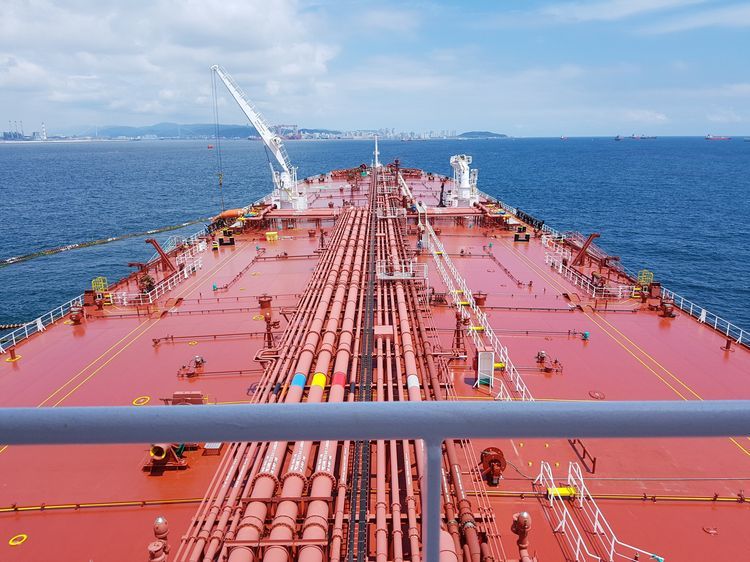
Captain Tsitrelis Ioannis and the 26-strong crew of the Malibu arrived at Ulsan in early August after sailing almost 9,000 nautical miles to deliver a million barrels of Kazakh CPC crude from the Black Sea to South Korea, one of the key buyers in the world’s biggest oil market.
Another cargo of light oil, which is less sulfurous than heavier grades, is set to arrive in a couple of months at Ulsan from even farther away — the US — to be processed by SK Innovation Co., South Korea’s top refiner. The two shipments are part of a stream of similar varieties flowing to Asia as companies look to process the kind of crude that yields more diesel to capitalize on surging demand for the fuel.
Last month, profit margins from making diesel in Asia touched the highest since November 2015, contrary to expectations for a typical seasonal drop in demand during this time of the year due to monsoon rains. The unusual gains have been driven by higher imports of cleaner diesel by India after the government imposed new quality standards and as China uses more to feed the expansion of its construction and industrial sectors.
“There’s no reason not to buy more,” Kim Wookyung, a spokeswoman at SK Innovation, said by phone from Seoul. “The margins of these fuels are pretty high.”
Profits in Asia from turning benchmark Dubai crude into diesel jumped to $14.38 a barrel on July 31, a gain of 57% since touching a nine-month low on May 4. The crack spread, as it’s known, was at $12.64 a barrel on Wednesday. The surge helped lift overall crude refining margins to $7.82 a barrel on Aug. 7, up more than 200% from a year earlier, according to data compiled by Bloomberg.
“Diesel demand has been strong in emerging economies, including the Philippines, Indonesia and India as they focus on increasing infrastructure spending,” said Peter Lee, an analyst at BMI Research. “China’s diesel demand has returned to growth in the second quarter as construction and industrial consumption picked up.”
That’s led South Korean refiners SK Innovation and GS Caltex Corp., among the top regional exporters of distillate fuels, to scour countries from Algeria to the U.S. in search of light crude.
Typically, lighter varieties with a lower sulfur content will yield about 85% of lucrative products such as gasoil and gasoline, and about 15% of residue. Heavier varieties, which are usually cheaper, would yield only 55% of valuable fuels, according to SK Innovation.
Still, the company — and most refiners — don’t process purely light or heavier crude at any given time. It blends about 15 different grades of oil before a crude distillation unit cracks it into products including diesel and gasoline. The proportion of varieties changes depending on market factors, according to an official at SK Innovation’s plant in Ulsan.
While low-cost drilling methods have unlocked vast deposits in places like Texas, supplies from U.S. shale fields are primarily light, low-sulfur oil, which many of the refineries along the American Gulf Coast aren’t designed to process. As a result, exports surged and America now ships more than some members of the Organization of Petroleum Exporting Countries.
More Attractive
Meanwhile, supplies of heavier crudes — which are more prevalent in the Middle East — have shrunk as OPEC nations including Saudi Arabia curb output as part of a deal aimed at propping up prices. That’s made regional benchmark Dubai crude stronger relative to other markers such as Brent and U.S. West Texas Intermediate, making them more attractive to Asian buyers.
“If you can get your hands on light crude now, it’s the time,” said Victor Shum, a Singapore-based vice president at industry consultant IHS Energy. “Given the current strong diesel cracks, refiners indeed should find light, sweet crude to be attractive.”
SK Innovation, which is diversifying away from its long-term crude suppliers in the Middle East, will load one million barrels of WTI Midland crude in late August from Freeport, Texas, and the same amount of Mexican Isthmus crude, with both expected to arrive in Ulsan in mid-October.
The increased appetite for light crude in new locations mean Captain Ioannis will be tasting new seas as he readies to embark on his next journey. While he’s still waiting to hear the destination, he doesn’t rule any country out. “I travel everywhere,” he said on board the Malibu, which was floating 3 miles off Ulsan.